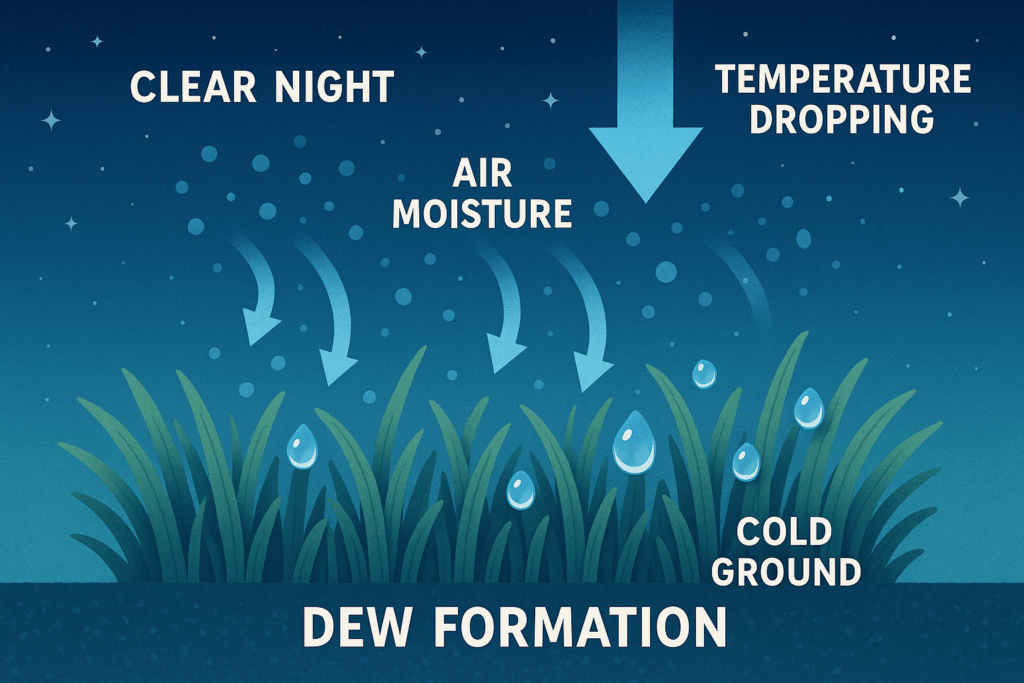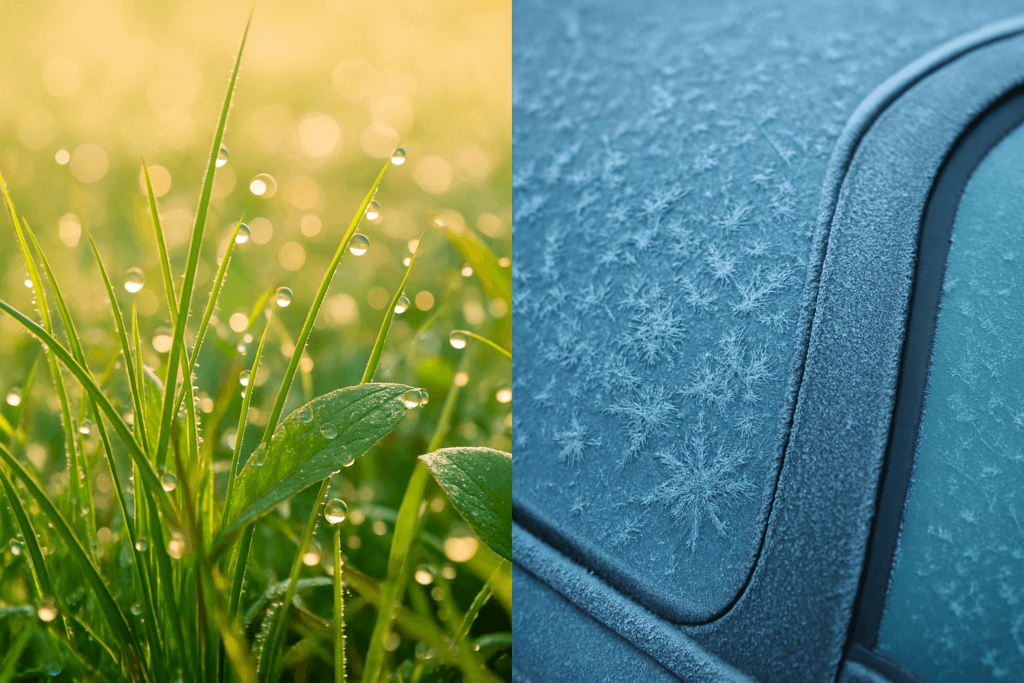Have you ever wondered why dew drops in the morning sparkle on the grass and leaves? Dew drops in the morning are a natural phenomenon that occurs when moisture in the air condenses onto cool surfaces as the temperature drops during the night. In this article, we will explore the science behind this fascinating process, why it happens, and how it affects both nature and daily life. Let’s dive into the world of morning dew and discover the secrets it holds!
1. What is Dew?
Dew refers to the tiny water droplets that form on surfaces like grass, leaves, and car roofs in the early morning. These droplets are not rain, but are formed from the moisture in the air that condenses onto cool surfaces overnight. Dew is a natural phenomenon that occurs when the air cools down and the moisture in the air condenses into water droplets. The process of condensation occurs when water vapor in the air comes into contact with cool surfaces, turning into liquid water. Dew typically forms during the night when temperatures drop and is mostly seen in the early morning before the sun rises.
2. How Does Dew Form?
The Role of Temperature
Temperature plays a crucial role in the formation of dew. During the night, as the sun sets, the air and the ground begin to cool down. As the temperature drops, the air can no longer hold as much moisture, causing the moisture to condense onto surfaces like grass, leaves, and car roofs. This is known as condensation. The cooler the air becomes, the more moisture it condenses onto nearby surfaces. The process of dew formation is most effective on clear nights when the temperatures drop significantly. On warmer nights, dew formation may be minimal as the air doesn’t cool down enough to cause condensation.

The Importance of Humidity
Humidity, which is the amount of water vapor present in the air, is another important factor in dew formation. When the air has high humidity, it contains more moisture, increasing the chances of dew forming. As the temperature drops during the night, the moisture in the air condenses into droplets on cool surfaces. If the humidity is low, the air does not have enough moisture to form dew. On humid nights, the moisture in the air is more likely to condense when temperatures drop, resulting in more noticeable dew in the morning.
3. Why is Dew More Common in the Morning?
Dew is most commonly seen in the morning because this is when the temperature is the lowest. As night falls, temperatures gradually decrease, and the air becomes cooler. During this time, moisture in the air condenses onto cooler surfaces, forming dew. The early morning hours are ideal for dew formation because, by then, the temperature has dropped enough for condensation to occur, but the sun has not yet risen to warm the surfaces. As the sun rises and the temperature increases, the dew gradually evaporates. This is why dew is often observed during the early morning, but by the time the day progresses, the sun’s warmth causes the dew to disappear.
4. Dew vs. Frost: What’s the Difference?
Dew and frost are both forms of condensation, but there is an important difference between the two. Dew forms when the temperature is above freezing (0°C or 32°F). During this time, moisture in the air condenses and forms liquid droplets. On the other hand, frost forms when the temperature drops below freezing, causing moisture in the air to turn into ice instead of liquid water. This process is called deposition. Frost forms when the air is cold enough that water vapor freezes onto surfaces, while dew is simply liquid water that condenses from the air onto cooler surfaces. Frost is typically seen during the colder months of the year when the temperature falls below freezing, while dew is more common in cooler, non-freezing temperatures.

5. The Importance of Dew for Plants
Dew plays an important role for plants, especially in areas where rainfall is limited. During dry periods or in arid regions, dew provides essential moisture for plants. In the early morning, when dew forms on the leaves, plants can absorb this moisture through their roots. This is particularly important in areas where rainfall is infrequent or in places with dry climates, such as deserts. Dew helps maintain the water balance of plants and can be a vital source of hydration for them. Without dew, many plants in such regions would struggle to survive. It’s especially useful for desert plants that rely on dew to sustain them during dry conditions.
Why Do Stars Twinkle? The Atmospheric Science Behind Starlight
6. Interesting Facts About Dew
- Dew Can Form on Any Surface: Dew can form on any cool surface, not just grass or leaves. You may notice dew on your car, windows, or even on spider webs in the morning.
- Dew Point: The temperature at which dew forms is called the “dew point.” This is the point at which the air is saturated with moisture and can no longer hold any more water vapor, causing it to condense.
- Dew and Crops: Farmers often rely on dew as a natural form of irrigation, especially in regions with limited rainfall. Dew can provide much-needed water for crops during dry periods.
7. Can Dew Be Used for Drinking Water?
In some places, particularly in arid regions, people have learned to collect dew for drinking water. By using special nets or dew collectors, dew can be trapped and collected into containers. This process has been practiced for centuries in desert areas where fresh water is scarce. While the amount of water collected from dew is small, it can still be a useful resource in regions with limited access to clean water. Collecting dew is a simple yet effective method to gather water in dry climates, where every drop counts.
8. Dew in Different Climates
Dew is more common in areas with moderate temperatures and high humidity. However, it can also form in dry regions if the temperature drops enough at night. In tropical areas, where it is warm and humid, dew forms almost every morning. In desert climates, dew can still form, but it is much less frequent and in smaller quantities due to the large temperature fluctuations between day and night. In temperate climates, dew is typically seen more frequently, especially in the early morning hours when the temperature is cool and the humidity is high.
9. Fun Examples to Understand Dew
- A Cold Glass of Water on a Hot Day: If you place a cold glass of water outside on a hot day, you’ll notice water droplets forming on the outside of the glass. This is the same process as dew formation, except the glass is cooler than the surrounding air. Similarly, dew forms on cool surfaces when the air cools down overnight.
- The Frosty Morning Car: On a cold morning, when your car is covered with frost, think of it as the car’s way of showing that it has been exposed to the cold for a long time. Frost is essentially frozen dew!
Conclusion
Dew is a simple yet fascinating natural phenomenon that occurs when moisture in the air condenses on surfaces due to cooling temperatures. It is most commonly observed in the morning after a cool night. Dew plays an important role in the environment, providing moisture for plants and helping to maintain the balance of nature. Whether you’re walking through a dew-covered garden or simply noticing the dew on your car window, it’s a reminder of the intricate science happening around us every day.
1. Why does dew form on grass?
Dew forms on grass because the blades of grass cool down during the night. When the temperature drops, moisture in the air condenses and forms water droplets on the grass.
2. Can dew form in the winter?
Dew is less likely to form in the winter because the air is usually colder. Instead, frost is more common during the colder months when the temperature drops below freezing.
3. Is dew harmful to plants?
No, dew is beneficial for plants. It provides them with moisture, especially during dry seasons or in areas with limited rainfall.
4. How can dew help farmers?
Dew can provide natural irrigation for crops, especially in areas with limited rainfall. Farmers in dry regions often rely on dew to help water their crops.
